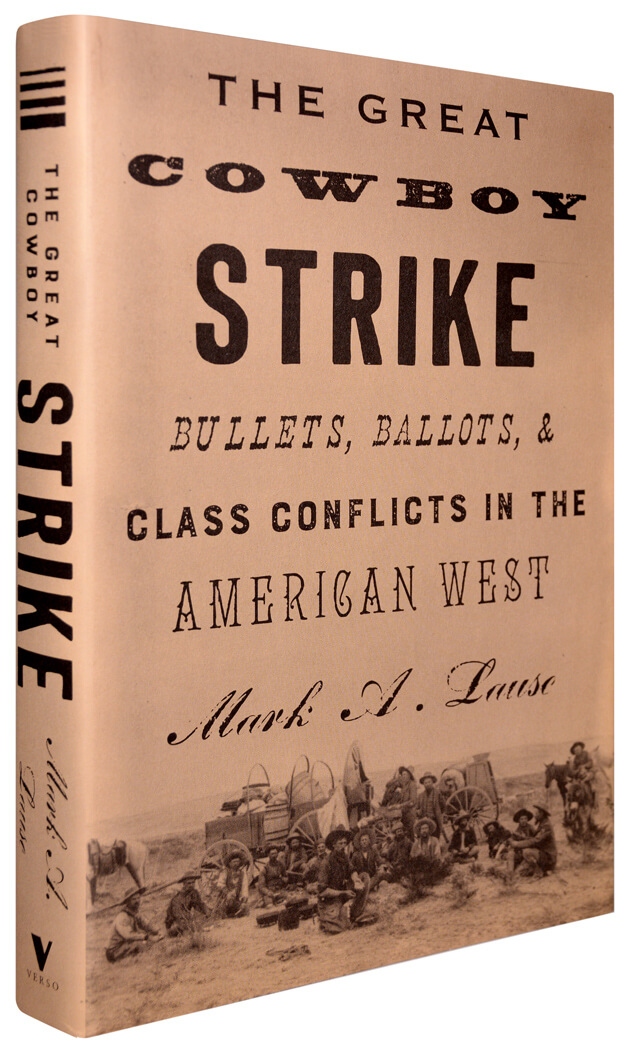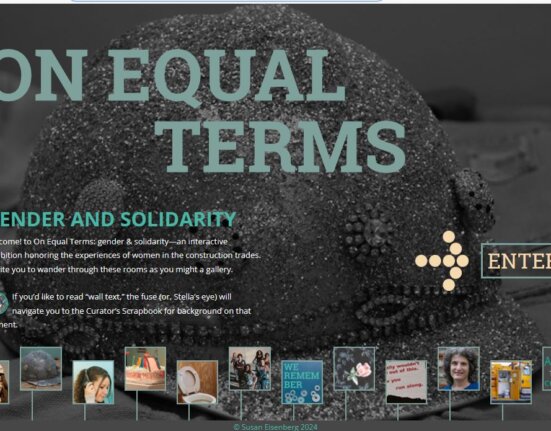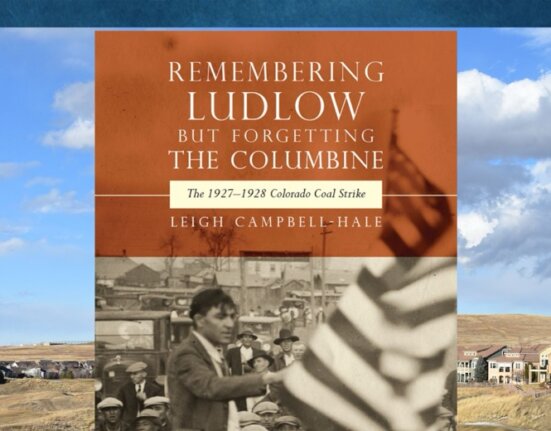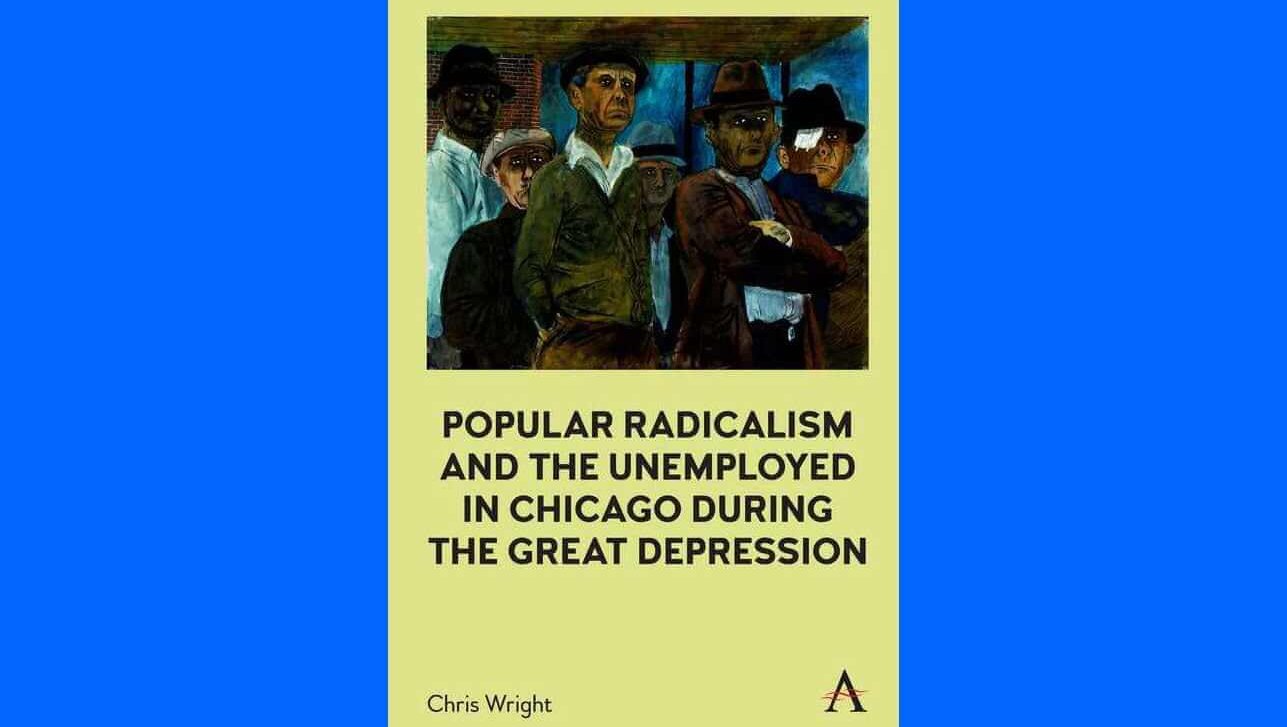Chad Pearson interviews Mark Lause on his new book, The Great Cowboy Strike: Bullets, Ballots and Class Conflicts in the American West, which subverts American mythology to reveal the class abuses and inequalities that have blinded a nation to its true history and nature.
Mark Lause questions
- Why did you write this book? And what was your intended audience?
Most immediately, my employers tend to always urge us to develop a wider range of courses, so I offered a course on the West some years back, and it really seemed to engage students. About the same time, I wrote that piece for LAWCHA’s Labor Online blog about Broncho John Sullivan, the response to which deepened my sense that there would be an interest in such a book.
In a larger sense, of course, those of us doing working class social history face a perennial challenge trying to ground what we do in what the profession and society generally tend to see as broader currents in American history. What I’ve tried to do in writing about the Civil War, spiritualism, land reform, bohemianism, and other such subjects have all attempted to nudge labor history towards trying to influence the evolution of that broader narrative we can anticipate.
As in much of my other work, I sought to demonstrate that class and class consciousness don’t exist in any substantive, meaningful way because people read Hegel in graduate school. It comes from the experience of class, from being a have-not in a civilization where your worth is really never more than the quantity and quality of what you own.
To state the obvious, not only are these categories of class always in flux, but there’s nothing that precludes all sorts of internal contradictions and inconsistencies. When you’re dealing with this particular group of cowboys, for example, you’re dealing with mostly Southern white boys, and the sense of where they fit into things certainly included many elements of race and gender that tended to mediate their sense of class.
- You challenge one of the core myths about cowboys. Can you explain this myth and how it emerged in popular culture?
The distinction between the myth and reality of cowboy life reflects that we’ve long made between history and heritage. That is, the serious effort to understand what happened in the past and why, as opposed to the marketable bundle of comforting myths about American Exceptionalism, group identity, and an unearned sense of virtue.
Almost everybody my age grew up with images of the West. Arguably, this reflected some persistent Jeffersonian assumptions about the primitively virtuous natural superiority of life beyond the complexities of cities and industries. We got a regular celluloid dose of the Turner thesis on a daily or near daily basis. There was a Saturday morning serial called “Cowboy G-men” that harnessed the rugged individualism of the Old West to the rationalization of the mass centralized warfare state and the agenda of the Cold War.
As you suggested to me at the time, Owen Wister’s The Virginian can inform a lot of our sensibility about this. He cast its cowboy hero as a company man, a civilizer of the West imposing the standards of hierarchy replicated from the settled east, the foe of the rustlers and gamblers, as well as the Indians. We’ve had over a century of western fiction, radio shows, television programs and movies, most of which reechoed the same approach.
We know this very well from our own times. The photo of the Dodge City businessmen from the 1880s dressed up in their cowboy gear reminded me of “Joe the Plumber,” John McCain’s human prop during his presidential campaign. Sam Wurzelbacher was already an avowedly right-wing Toledo businessman the Republicans presented as the voice of the blue collar worker, at least white male blue collar worker. The media and the mechanisms of culture swallowed this without the least indigestion, and Democrats began to talk about the need to cater to concerns “Joe the Plumber” expressed in the name of appealing to workers.
Indeed, the same thing happened in the 2016 presidential election, where you had a crosstown contest between two candidates representing factions of the elites in the New York City area. Trump’s victory got blamed on the areas the Democrats had neglected in the Midwest, the South, and the West. And—despite all the demographic evidence to the contrary—the elites and their talking heads accept the casting of Trump as the voice of the discontented working class, of a “populist” discontent.
It is only fair to acknowledge that academe also plays a willing role in this process.
- Why is the 1883 Texas panhandle strike important?
They were probably as unlikely a group of workers to organize collective action as we could have. They were seasonal workers with no job security and nothing like we would call a work history. Their part of the work force was as fragmented as were their own lives. They were mostly young white boys, orphans of a defeated South with tenuous family or serious prospects. Surely, they tended to cling to whatever they had going for them, racial identity being a particularly obvious feature of it.
And, of course, the peculiarity of the 1883 strike was the relative extent of its documentation. Other strikes took place across the west, including at least one earlier one in Kansas that left little in terms of documentation because the employers thought it better for them to settle things quickly and quietly, without making widely publicized threats.
The location of these strikes were, by definition, in the wide open spaces of the West, far from the population centers and newspapers. Their experience in such places created a radicalism entirely legitimate in its context. Too, as interesting as the cowboy strikes themselves were, they provide insights into the broader assumptions about the West and the process of settlement, the nature of politics, race, and empire in the Gilded Age. The cowboy strikes, cooperatives, political insurgencies and other related experiences underscore the nature of radicalism as growing out of the experience of class. Class struggle isn’t an exotic import from Europe to the Americas, or from the East to the West or the North to the South.
This was the great insight of the New Left scholarship of the 1960s, though, like the subjects themselves, they tended to render themselves harmless with domesticated theory and language. Someone asked me once whether the cowboy strikers and the Western insurgents exercised “agency.” The term covers a wide range of techniques to influence those with power. My dogs exercise “agency” when they whine at me to take them to the park, but the term actually misrepresents things if the dogs were nabbing the car keys and driving themselves there at a time of their choosing.
Neither the cowboy strikers or their bosses understood what they were doing in such bleached terminology. What they were doing was about power and who was going to exercise it.
- The book isn’t just about class struggles from below; we also learn much about elites. You write “Understanding these struggles—and how they came to be so obscured—requires seeing their context: in the broader insurgencies that politically challenged the unquestioned power of the large ranchers, the railroad owners, and the mine bosses.” Can you explain why it is important to study the ruling class?
If we approach this from a Marxist perspective, class doesn’t exist sui generis. Life under capitalism makes a working class, and it exists in different ways in the different conditions of life capitalism provides.
Consider the differences between the experience of African American chattel slaves on a Southern plantation and that of skilled white craftsmen in a contemporary city in a nonslaveholding state. Or we could talk about workers living on their own in a wider urban context, as opposed to living in a small company town. Just consider the varieties of experience of working class women in these different circumstances, and how those circumstances create degrees of difference with their male counterparts. These reflect real differences in how a capitalist system manages its class rule.
In the context of this setting, a cowboy, a railroad worker, or a sex worker may share a class identity insofar as class requires some level of consciousness, but how they experience class informs that consciousness. Consider farmers, who labor historians always take pains to distinguish from workers. In fact, the line was often smudged. Where I grew up, it was very common for people struggling to retain their family farms to take factory jobs in order to supplement it.
Then, too, farmers in the period we’re discussing spoke of themselves and the workers as part of “producing class.” They argued that their ownership of the land they farmed was always conditional, and no more made them capitalists than was a machinist who owned their own tools. If we want to read class from the inside out, from its context, we have to entertain these perceptions, but they were perceptions that reflected how capital controlled the marketplace and defined the role of small farmers.
When we’re dealing with history, we also have to take into consideration that we are now living under a more homogenized capitalist structure than our predecessors of a generation or so earlier. If we consider how it exercises political management or engages in repression to maintain control over various sections of the laboring population, the ruling class today certainly isn’t as factionalized as in the nineteenth century.
- In some ways, your book reminds us of the deep roots of the political bankruptcy of the two mainstream parties. How did operatives working for these parties help to prevent the creation of parties more sympathetic to the interests of working-class people?
Everyone who studies history knows—or certainly should know—that we, the people, live under a government designed by slaveholders and merchant princes behind closed doors and an electoral system that emerged from their cultivation of caucuses to pursue their distinctive special interests within that government. Governing slaveholders not only shackled their slaves but bound the entire society to a system that sustained slavery and racism in service of their own profits and privileges. Political parties claim to be the natural reflection of public opinion through their campaign promises or claimed values or whatever partisan inclinations voters have gotten from previous generations within their families or communities.
After half a century of directly studying every election that’s passed by me, I’m confident about several simple truths. In almost every election, about half of those people qualified to vote generally don’t participate and most of those that do are holding their nose to vote for something they don’t want slightly less than something they don’t want more.
Corporate media which exercises a monopoly over public perceptions of the electoral process does its level best to pretend otherwise. They try to get and keep people excited over electoral politics the same way they want people excited about sports on TV. They are good at that sort of thing—the sports coverage, soap opera scandals, and the bling of celebrity. In politics, they are the real arbiters of who is and isn’t a so-called “serious candidate” and who gets coverage, and, at this point, they’re quite openly measuring that “seriousness” based how much money candidates can raise. Now, why is that? Why do the candidates need so much money?
Who’s going to ultimately receive it? The lion’s share is going to go to the very media businesses that are defining who gets the best treatment. No conflict of interest there, right? And, under their tutelage, American political campaigns have gotten longer and longer over the course of my life. And the only reason for it is to inflate the cost of running for public office.
What I’ve also observed over all these years of watching is that, scholars who’ve written solid, honest dissertations about these sorts of things tend to compartmentalize all that in their brains no less than anyone else as soon as the talk turns to electoral politics. The discussion quickly starts to sound like people in a bar discussing their favorite sports teams. That is a disconnect that prevails even as we approach the ivory towers.
Modern universities in the West grew from roots in the medieval Church, and that heretics can’t expect to win arguments there. In fact, they should feel fortunate if they’re even treated in an even-handed way. Important institutions don’t stay important by challenging other important institutions.
Nobody should get into this expecting that we’re going to make such a brilliant argument that the rest of the profession is going to suddenly open its eyes and recognize that we’ve been right all along. Individuals might, but the profession generally can’t be expected to do more than give us some room to do our work. A reasonable measure of our success is just to be able to formulate and promulgate a radical challenge to the orthodoxies.
This is an argument that’s ultimately going to depend on what happens in the wider society.
And it’s never going to be a fair argument. Depending on the polls, about half the electorate wants a new political party and they have for a long time. Until that’s organized enough to start taking a portion of the national platform, we aren’t going to have much new in the political culture.
- One of the most interesting characters in your book is a guy named William A. A. Carsey. He seems to have been one of the original AstroTurfers in US political history. Can you tell us a little more about him and why he is important?
I first encountered Carsey in press accounts of the meetings of the First International in New York City and, over the years, I noticed his name popping up again in other contexts. When I researched him more thoroughly, he turned up as a building contractor during the period of the Tweed Ring and political appointee to various government positions from the city to the national government. At different points, he functioned closely in tandem with Tammany Hall, or with Peter Cooper and Abram Hewitt, and with Governor David B. Hill.
When the Greenback movement started, he formed his own Greenback group that participated in the formulation of the movement’s electoral policies and even nominated the national ticket in 1876, but afterwards pulled back in the interests of the Democratic Party. After an insurgency peaked and collapsed, his group took up the name of the independent party and spoke on its behalf. So, after the Greenbackers or the Antimonopolists or the Union Labor party made their bid to launch an independent party and failed, Carsey and his circle would hold public meetings under the name of the movement and act on behalf of the Democrats.
He also seems to have made his name and that of his phony “labor” organizations available to employers for a price. They sponsored phony “labor” meetings to oppose strikes and rather straightforward government reforms, when the Democratic Party opposed them. Although it largely existed only on paper, he established a Knights of Industry to oppose the Knights of Labor, particularly repudiating strikes.
But there is a direct line between the Occupy movement and the eagerness with which the label was adopted by corporate and institutional entities such as Occupy Democrats. Or how the drive to establish an independent environmental party got bogged by state Green parties uninterested in building a mass democratic membership-based organization and dominated by people who see curtailing independent action as a means of bartering for something with the Democrats.
That sort of career becomes possible, in large part, because of the national character of the insurgency. It was very easy for someone like Carsey to present himself as the leader of a real third party movement or a mass labor organization in New York City if he was doing something outside of the city. We see groups in Indiana or Kansas or Alabama.
Carsey merits a study in his own right, because the nature of the two-party system in the U.S. creates such careers.
However, every move towards launching a genuinely oppositional political party in the U.S. is derailed by people playing the same role as Carsey to the same purposes.
The Green Party in my state has pretended to be a political party for over twenty years, while it studiously avoids anything that a serious party movement needs to do. For years, it claimed and had its voice in the councils of the national parties, as to who got the nominations and what the platform would look like. Then, they’d come home from the convention and support the Democrats. After a few years of squelching discussions, packing meetings, and preventing any serious move towards organization, individual leaders would fade off into the so-called progressive wing of the Democratic party.
There are many things you could say about it, but it surely wasn’t the least bit original. “History is not the past,” as James Baldwin reminded us. “It is the present. We carry our history with us.” If we do not address this, we will never reach the point where traditions chains will no longer bind us.
- Your study, like so many others, illustrates the broadness of labor history. Indeed, so many non-labor historians continue to make the erroneous claim that labor history is principally the story of white men in industrial unions. How should we respond to these people?
All we can do is make the argument and continue raising the issue, though I would temper any expectation that we can create a new general consensus among historians.
The historical profession grew from the work of essentially patrician chroniclers who shared fundamental assumptions about the nature of the country, class, race, and gender. The loudest voices were those with the most resources to magnify them. When the field became academic, it broadened participation, but retained those essential assumptions. Over time, this expanded to include more people of color, more women, more plebeians. Like the expansion of the suffrage, it did so within clear limits. Dominant voices and concerns remain dominant.
The profession has accommodated the interests of this broader influx of scholars in large part by ghettoizing fields. There are certainly reasons for this. Scholars engaged in African American, Native, Hispanic, or the history of women or LGBT communities are tapping into relatively neglected areas and vast rich fields for inquiry naturally create specializations that tend to seem closed off to the profession in general. These areas have sought and found constituencies outside of the profession, as has labor history.
At the same time, any kind of legitimacy within the profession often requires legitimating its mythologies, at least to the extent of not challenging them.
To a great extent, labor history has drifted from the history of labor movements, precisely because labor organizations themselves no longer function as movements. The strength of a labor movement has always been in the power of the rank and file, and a vision of the future that turned on building more and bigger unions with a democratically engaged membership.
Organized labor proved one of the most eager to ignore the broader social questions of race, gender, war and peace. The AFL-CIO leadership has retreated to the right along with the Democratic Party, and has even threatened officials that might, for example, express any sympathy for the forlorn hope of Bernie Sanders to resurrect that kind of reformism. Among labor historians, this complicates the predispositions in academe generally, to take a critical approach to the subject.
The real test of a historical thesis is going to be history. And what we’re discussing is a history that has yet to be made.
Being the gadfly, the heretic is an important role at this point.
- Finally, you are a remarkably prolific scholar. Can you please tell us how you approach the writing process itself?
**
Thank you, but I’m afraid I have to confess that this reflects a certain intellectual laziness and indiscipline, I suspect.
All of us do our best and strongest work when we allow it to capture us, when we are following our curiosity and doing what we want to do. Since starting graduate school, I’ve always had at least two or three book projects in the works and some notional ideas of other things I’d like to do later. So, among the various projects I’m pursuing, I’m always more passionate about one than the others, so whatever I’m doing always interests me the most.
I finished the last book manuscript and sent it off with a clear idea of what I wanted to do next, but it seemed to loom like a job. So I set everything aside for a couple of weeks. Read some books, poked at some general notes, and found another project that seemed much more interesting. I may finish it before I get to the one that I thought I should do. Or I may find the originally scheduled project more interesting at some point and switch to that one.
Put another way. I don’t tie myself down to finishing a project simply because it might be closest to finishing than the others. You have to have confidence that you’ll finish it at some point. So far, that’s generally proved to be true in my case.
I’m always aware that trying to cram whatever I’m doing into the truncated career the profession deigned to give me. On one level, had the historical profession really wanted me to have a more standard career arc, I would have been employed years before I was, and accorded the same sabbaticals, grants, and support others have had.
But each of us has to play the hand we’re dealt as best we can, and I regard myself as having a much better hand that I had ever had any reason to expect, and am very fortunate getting to do what I do.
And I am equally fortunate having so much work I still hope to complete.






